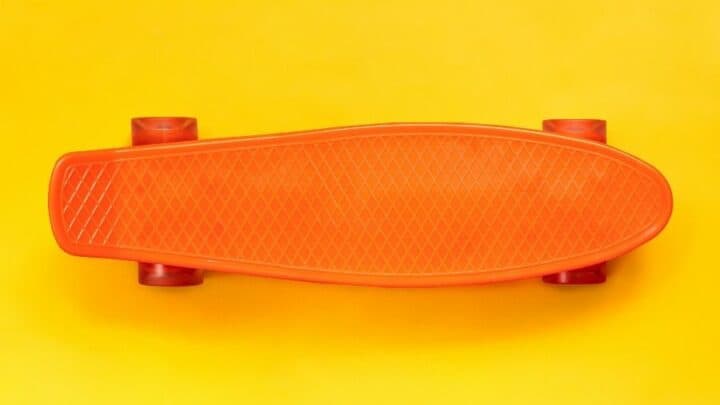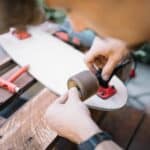So, you can’t tell a cruiser from a longboard? You might think that they are special types of skateboards, but that’s not exactly right.
Broadly speaking, we can divide skateboards into three main categories: cruiser, longboard, and skateboard (yes, I know, that’s weird. Never mind, I explain it below).
Table of Contents
What is a Cruiser Skateboard?
A cruiser skateboard is a portable, mid-sized skateboard (between the lengths of a longboard and a skateboard). Cruisers are stable, stiff, and relatively slow. They are not meant for racing or doing tricks. Cruiser skateboards are best for use in urban areas with level areas of pavement.
Characteristics of a Cruiser Skateboard

What is a Cruiser Skateboard?
Cruisers aren’t designed to do tricks like skateboards. They’re not built for speed or going downhill.
These are the key design features of cruisers:
Although shorter than longboards, they serve the similar purpose of offering a stable ride for purposes other than executing high-performance tricks.
On a longboard, you’d happily bomb downhills or race your friends. You’re unlikely to do either on a cruiser.
- They are easy to transport.
- They are of short or medium deck length.
- They have large, durable wheels in comparison to skateboards.
- Sometimes, they have a kicktail in the back. (A kicktail is the portion of the board that curves up at the back.)
- They are created specifically for local travel.
- Some pedants are so specific with what makes a skateboard that they won’t use “cruiser skateboard” as a term. Instead, they will only say “cruiser”. To be honest, I am such a pedant. I don’t like the term “cruiser skateboard”. So, for the rest of this article, you will know what I mean when I say “cruiser”.
All said and done, just understand that a cruiser is a skateboard for short, level-terrain cruises.
What Skateboards, Longboards, and Cruisers are
Some people don’t want to learn and master skateboard tricks. Many just use skateboards to get around.
The following information should be helpful:
Longboard
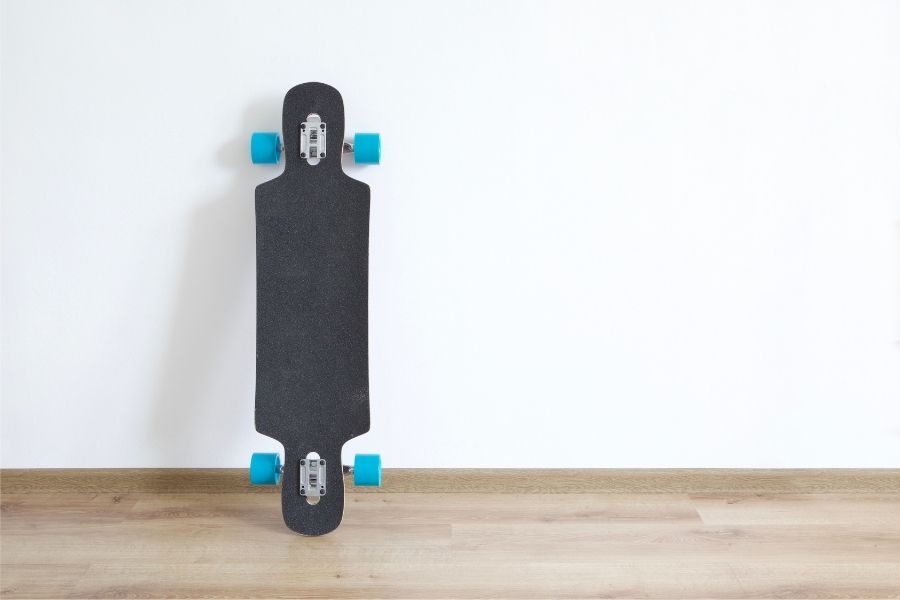
Longboard
Designed to travel long distances with maximum comfort. It is less portable but can be used for long distances.
Longboards are not suitable for fast riding or tricks.
Cruiser
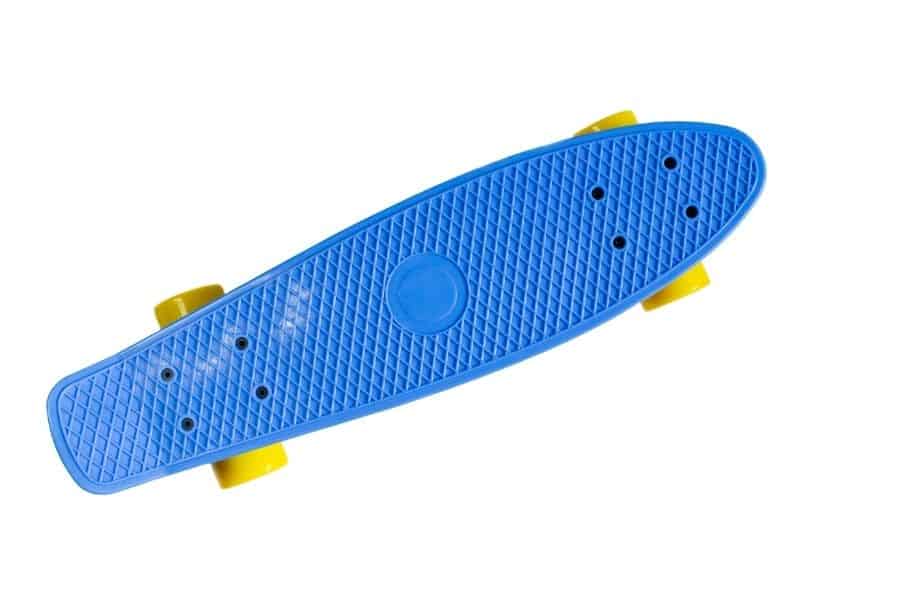
Cruiser Skateboard
Made for short distances. It is lighter and more portable but still requires better balance than on a longboard.
It usually has a kicktail for easy pickup or manual, simple tricks.
Skateboard
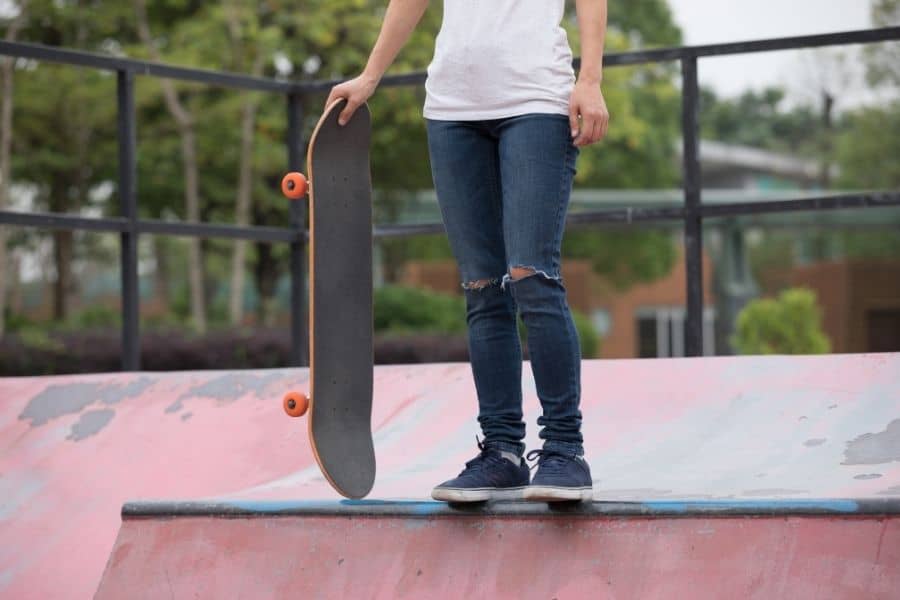
Skateboard
Designed for speed, tricks, and showing off your skills. Not really meant for ordinary travel.
Most properly constructed skateboards are double-kick, which means they have raised ends both the front and back. This is in contrast to cruisers, which have a kick only in the tail.
Longboards and cruisers are more stable due to their larger risers and softer, bigger wheels. These larger wheels protect the rider from small obstacles.
Consider a cruiser or a longboard if you want calm, level riding. Longboards can be compared to cruisers in that their length makes it easier to balance, but they also fight against turns because turning on a longboard is stiffer.
This means that longboards are ideal for long, straight commutes. On the other hand, cruises are a great option if you do lots of turning in your day-to-day travels.
Mini Cruisers
A sub-group of cruisers is the mini-cruisers. They are exactly what they sound like, cruisers, only smaller to provide even more portability.
Mini-cruisers are made from extremely light materials, which is attractive to riders looking for more carving potential and tighter turning. A mini-cruiser is so small you might be able to fit into your backpack, whereas a regular cruiser would stick out of the top like a sore thumb.
Both beginners and more experienced riders love mini cruisers. For beginners, that’s because, although small, mini-cruisers still deliver a comfortable, slow-and-steady experience.
For more experienced riders looking to get into tricks, mini-cruisers can do basic tricks and flips until the rider is ready for a proper skateboard.
Tip: Mini-cruisers can do basic tricks and flips, but they will never go fast, no matter what.
So, are you a Cruiser
First, decide if you are interested in skating ramps and learning tricks. If so, you really should get a proper skateboard.
However, suppose you aren’t confident in your skating. In that case, a cruiser is a good choice to help you get some skateboarding experience under your belt.
You can always easily upgrade later to a freestyle or double-kick skateboard.
A longboard or cruiser is a great option for those who don’t want to take up skateboarding as a serious sport. Basically, the longboard is the most stable, least agile board.
Longboards are followed with (a little) less stability and more agility by the cruiser. Cruisers are followed by the board with the least stability but most agility, the skateboard.
Choosing the Right Type of Cruiser Skateboard
Like longboards and skateboards with many sub-categories, cruisers can also have overlaps.
If you already know what type of cruiser you want, take a look at these examples.
- Cruisers: are comfortable boards for adults and children of all sizes. Cost ranges between $50 and $80.
- Mini Cruisers: Great for younger children, but still pretty good for anyone who needs a light, small board. Mini-cruisers will set you back around $40.
- Penny boards: low-cost, small, plastic cruiser or mini cruiser. Penny boards have narrow decks and can turn well, so children love them. Prices vary depending on the brand, but they start out at around $30 and go up from there.
- Surfskates: aka carves, are a unique design that allows the board to tilt. These boards are popular among surfers but are also used for cruising.
Just as with skateboards, there are three types of surfskate: cruisers, longboards, and skateboards. Each type has a different price range.
Frequently Asked Questions about a Cruiser Skateboard is
My all-new cruiser is so stiff I can barely steer it. Should I return it?
Your new cruiser’s trucks have been adjusted to factory settings. The cruiser won’t turn well enough to allow you to skate corners if the setting is too restrictive for your body weight. Find the kingpin nut at the center of each truck, and loosen it. Check that as you turn with all your weight to one side, the trucks come close to touching the skateboard.
Is it true that I shouldn’t skateboard if the ground is wet or it’s raining?
Water can easily and quickly destroy your cruiser for 2 main reasons. First, the cruiser’s wheels’ metal bearings are not waterproof and will rust quickly and simply stop rolling. Second, the cruiser’s wooden deck will absorb water and become “waterlogged”. Additionally, the deck’s plies will start to separate.
Afterword: What is a Cruiser Skateboard
A cruiser is a perfect compromise between a longboard and a skateboard. It’s suitable for both men and women, young and old, depending on their preferences.
It’s a good idea to check on your ambition if you’re buying your first board. Do you want to master tricks?
Or do you just want to cruise the city streets? In that case, get a cruiser.
Then get a skateboard and pretend it’s a cruiser until you’ve perfected your stunts.
Whichever way you go, happy skating.
